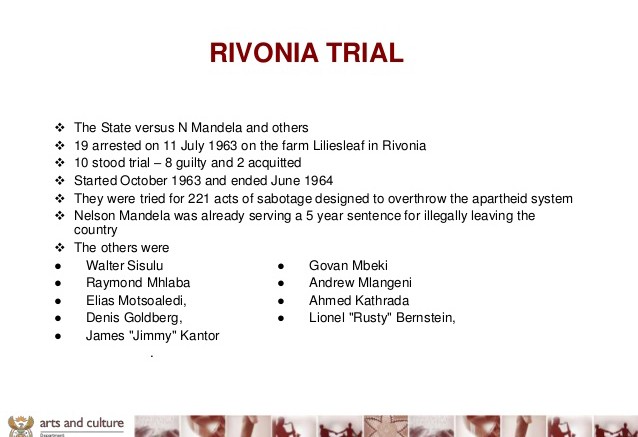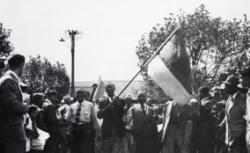Fifty years after the beginning of the Rivonia Trial, officially known as the State versus Mandela and others, we are able to look at what happened in the light of the literature that has been published since 1994, the dawn of South Africa’s democratic era.
Context and Overview: The Rise and Fall of Resistance
The Rivonia Trial was an event that brought to a conclusion an intense period of resistance and agitation against apartheid that began with the resuscitation of the ANC after its radicalisation by the ANC Youth League. When Anton Lembede, Nelson Mandela, Walter Sisulu and their comrades formed the Youth League in the mid-1940s, they began to plan major campaigns against state oppression, drawing up the Programme of Action in 1949.
Following the Indian Passive Resistance campaign against the Pegging and Ghetto Acts in 1946, aimed at limiting business and residence rights of Indians in South Africa, the ANC embarked on the Defiance Campaign in 1952. But the apartheid state cracked down on all forms of resistance, at first outlawing the Communist Party of South Africa (CPSA) in 1950. As the Defiance Campaign lost its momentum, ANC and Congress Alliance leaders were put on trial for treason in 1956, in what became known as the Treason Trial. The state failed to prove that the ANC was a communist organisation and was unsuccessful in its efforts to eliminate the ANC and its leaders, and they were set free in March 1962.
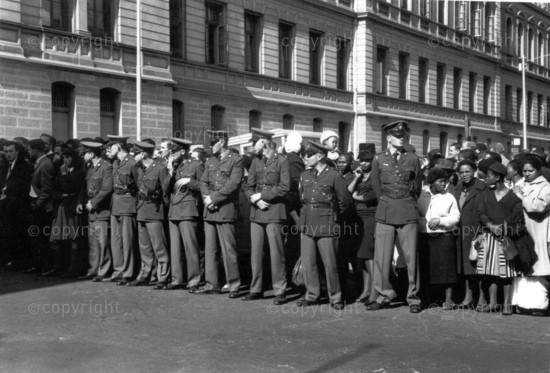 Policemen outside court during the trial. © Baileys African History Archive / Africa Media Online
Policemen outside court during the trial. © Baileys African History Archive / Africa Media Online
In 1952 the CPSA was relaunched as an underground organisation, now named the South African Communist Party (SACP). Another organisation that sprang up during the decade was the Pan Africanist Congress(PAC) which was formed when its members broke away from the ANC in 1959. The PAC launched its anti-Pass Law campaign, which culminated in the Sharpeville Massacre, a State of Emergency and the banning of the ANC, PAC and other organisations. The PAC, as well as the ANC in concert with the SACP, began to consider military campaigns to resist the apartheid state, and the ANC formed a military wing, uMkhonto we Sizwe (MK), while members of the PAC did the same, launching Poqo. Around the same time, some members of the Liberal Party also launched the African Resistance Movement (ARM), an organisation aimed at carrying out sabotage attacks against the state.
The ANC tasked Oliver Tambo with the establishment of an external wing outside the country, and he went into exile and began setting up offices in various countries, beginning in Dar es Salaam, Tanzania, then in Ethiopia and Algiers in Algeria.
Both MK and Poqo embarked on sabotage campaigns. MK operations began on 16 December 1961, when the organisation announced its establishment. Nelson Mandela went on illegal trips on the continent to drum up support for the ANC from newly independent African countries, and he returned to South Africa in the midst of an intense police campaign to arrest him. Known as the Black Pimpernel, Mandela evaded arrest for 17 months, but was eventually captured and tried in August 1962. He was sentenced to 5 years in prison for incitement.
Before his arrest the MK High Command began to consider a military campaign, a plan titled Operation Mayibuye. The SACP, in the meanwhile, bought a farm north of Johannesburg in Rivonia, called Lilliesleaf, which the party used as a base for underground operations. It was here that police conducted a raid which saw the arrest of members of the ANC, MK and the SACP: Walter Sisulu, Govan Mbeki, Raymond Mhlaba, Ahmed Kathrada, Lionel Bernstein, and Dennis Goldberg. Andrew Mlangeni and Elias Motsoaledi were arrested later.
The police also found documents related to sabotage campaigns, including the plan for Operation Mayibuye. The men were detained for three months while the state ‘gathered evidence’, and Nelson Mandela was added to the list of the accused, and brought from Robben Island to face trial with his comrades. The Rivonia Trial began on 9 October 1963, and lasted 86 days. It culminated in the conviction of most of the accused on various charges, and they were sentenced to life imprisonment.
The incarceration of the leaders of the ANC, MK and the SACP marked the beginning of a period of brutal state repression against any form of resistance by any organisation of the oppressed, a period of quiescence that only ended with the rise of the Black Consciousness Movement in 1968.
Operation Mayibuye
Nelson Mandela first discussed the possibility of using violence against the state in the early 1950s, but it was only in June 1961 that he raised the issue with the ANC’s Working Committee, and on that occasion Moses Kotane, who was an ANC executive member as well as the secretary of the SACP, vigorously opposed the idea. But Mandela convinced him and Kotane did not oppose the idea when Mandela again brought up the issue at a meeting. Eventually, he was authorised to form uMkhonto we Sizwe.
David Welsh, in a book published in 2009, says:
‘Operation Mayibuye was the strategic plan, drawn up in 1963, whereby MK proposed the transition to guerrilla warfare. Hundreds of MK recruits would go abroad for military training, thereafter returning to four rural areas to be joined by thousands of local recruits. Attacks would be launched on strategic targets, complemented by urban sabotage and mobilisation for protest. Including a national anti-pass campaign. By mid-1963, 300 people had been sent abroad for training. The plan was accepted by the High Command, although it evoked strong opposition in the SACP’s Central Committee.’
Mandela formed a High Command, which included Govan Mbeki, Joe Slovo, and Jack Hodgson. Joe Slovo was tasked by the Central Committee with presenting the plan for consideration by the leadership in exile. Ahmed Kathrada, in a book of memoirs published in 2004, reveals that he was one of the sceptics with regard to Mayibuye. Mandela later wrote:
‘As far as I was concerned, Operation Mayibuye was a draft document that was not only not approved, but was entirely unrealistic in its goals and plans”¦ I did not believe that guerrilla warfare was a viable option at that stage.’
According to Kathrada, Walter Sisulu was equally sceptical. Bernstein, according to Kathrada, said that the ‘chief proponents of of Operation Mayibuye were Govan Mbeki, Joe Slovo and Arthur Goldreich’, and that Bernstein himself thought the plan ‘lacked political depth’ and a misreading of the balance of forces.
Lilliesleaf Farm
The South African Communist Party established a ‘front company’ Navian Ltd to purchase Lilliesleaf Farm, so that it could function as a ‘safe house’ for meetings of the Party’s Central Committee. Vivian Ezra was its sole director and on 21 August 1961 signed the offer to purchase. James Kantor and Partners handled the transaction on behalf of Ezra.
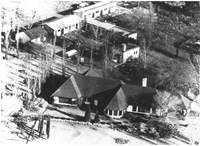 Lilliesleaf Farm
Lilliesleaf Farm
While Mandela was on the run, during his ‘Black Pimpernel’ phase, he lived at Lilliesleaf, pretending to be a caretaker, under the alias David Motsamayi. Once the dilapidated outbuildings and main house were renovated, Arthur Goldreich and his family moved into the main house, ostensibly as the ‘white front’ tenants, after signing a lease with Navian Ltd. Mandela moved into an outbuilding and during his brief stay at Lilliesleaf MK conducted its first acts of sabotage.
In January 1962 Mandela left for Addis Ababa for a meeting of the Pan-African Freedom Movement for East, Central and Southern Africa (the precursor of the Organisation of African Unity). He then travelled throughout Africa to raise support for MK, visited the United Kingdom and underwent military training in Ethiopia.
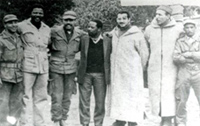 Nelson Mandela, second from left, with members of the National Liberation Front of Algeria. In March of 1962 Mr Mandela received training from the Algerian National Liberation Front at bases of the latter across the border in Morocco. Source: Pretoria News Library.
Nelson Mandela, second from left, with members of the National Liberation Front of Algeria. In March of 1962 Mr Mandela received training from the Algerian National Liberation Front at bases of the latter across the border in Morocco. Source: Pretoria News Library.
When Mandela returned to Bechuanaland (Botswana) he slipped across the border and drove directly to Lilliesleaf, where, the next night, he met with the Working Committee who debriefed him on his mission. Despite his comrade’s reservations, Mandela was determined to brief the ANC’s leader Chief Albert Luthuli who was living under house arrest in Groutville, Natal. Mandela made it through, but while driving back to Johannesburg he was intercepted by the police near Howick, Natal and captured, on 5 August 1962. Mandela was subsequently sentenced to five years in prison for leaving the country illegally without a passport and inciting workers to strike.
Nelson Mandela, second from left, with members of the Algerian National Liberation Front in Morocco, 1962.
According to Welsh, it soon became the nerve centre of MK, and he goes on to say that its reclusiveness ‘bred a fatally casual attitude to security’. He quotes Rusty Bernstein in support: ‘Things which need not have been done there, were, because it was easy and available. Things that should never have been kept there, were; and people who should not have known of its existence were taken there”¦.
Unconsciously, MK was turning our safe-house into a place of peril.’ It is generally accepted that an informer told the police of the hideout, and neighbours told the police that the farm ‘was visited by a steady stream of well-dressed black men’.
The Raid
Security Branch police raided the farm on the afternoon of 11 July 1963, concealed in dry cleaners van and by nightfall arrested 17 people. Lieutenant Van Wyk, Detective Warrant Officer Kennedy, Detective Warrant Officer Dirker, Lieutenant Van Heerden and several other Security Branch policemen secured the premises and arrested Walter Sisulu, Govan Mbeki, Raymond Mhlaba, Ahmed Kathrada, Lionel Bernstein, and Bob Hepple who were in the thatched cottage discussing Operation Mayibuye. Denis Goldberg was seized inside the main house and the police combed through material at Lilliesleaf Farm during the raid.
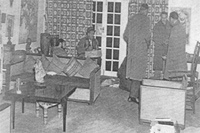 Arthur Goldreich is seated far left, while Warrant Officer Dirker seated centre compiles a crime scene inventory.
Arthur Goldreich is seated far left, while Warrant Officer Dirker seated centre compiles a crime scene inventory.
Arthur Goldreich drove into the driveway, around the time Colonels Klindt and Van den Bergh arrived at the farm. Police considered Sisulu the prize, having a while before mounted a manhunt for the ANC Secretary General. Police found stacks of incriminating documents: pamphlets issued by the ANC, SACP and MK, left-wing literature, and crucially, the plan for Operation Mayibuye.
The men were whisked away to the Johannesburg Fort and some to the Marshall Square police station, and kept in detention under the Ninety Day Detention Law (General Law Amendment Act), which was passed on 1 May 1963, and made it possible for police to keep political prisoners detained for 90 days without being charged and without having access to lawyers. Police also arrested Harold Wolpe while he was about to cross the border into Bechuanaland (Botswana) in an attempt to leave the country, and later his brother in Law, James Kantor. Besides the accused, all the farm workers were held under the 90-day law, and later induced to act as state witnesses.
Prelude to the trial
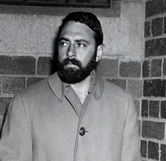 Arthur Goldreich one of the accused who escaped before the trial.
Arthur Goldreich one of the accused who escaped before the trial.
In the weeks before the trial, several dramatic events took place. Harold Wolpe, Arthur Goldreich, Abdullah Jassat and Mosie Moolla escaped from prison after bribing a young policeman, Constable Johan Greef, who facilitated their exit.
The four left the country as newspapers splashed details of their dramatic escape. Goldreich and Wolpe, were smuggled inside the boot of a vehicle into Swaziland, at the time a British protectorate, and once disguised as priests flown to Bechuanaland. The police were deeply embarrassed by the episode, and turned their anger on those they had in custody, and especially on James Kantor, Wolpe’s brother-in-law, whose legal practice facilitated the purchase of Lilliesleaf.
Bram Fischer, the distinguished lawyer who was the leader of the underground SACP, took on the task of defending Mandela and his co-accused. Canon Collins of the International Defence and Aid Fund (IDAF) raised at least £20,000 to fund the defence, as he had done for the defence in the Treason Trial, after receiving a request from Bram Fischer. From the outset, Fischer knew that the best that could be achieved would be to avert the death sentence, and he saw it as the mission of the defence to save the men’s lives – anything more would be too much to hope for.
The trial became the focal point of local and international attention and set in motion the destruction of the ANC led underground and the launch of the sabotage campaign. It would take another 27 years before Mandela and all political prisoners were released and the liberation organisation unbanned.
Eventually, 11 men were put on trial, these were:
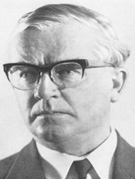 Bram Fischer one of the defence lawyers
Bram Fischer one of the defence lawyers
The Trial
The trial began on 9 October 1963 in the Palace of Justice, which was ringed by a heavy contingent of armed policemen. The 11 accused emerged from the basement of Court Three, their friends and relatives taken aback by their appearance – they had obviously been through traumatic experiences. Mandela, who had been sent to Robben Island soon after his arrest, was dressed in prison khaki shorts and shirt, and had lost at least 10kg. According to Hilda Bernstein, his face looked hollow, and his complexion had taken on a ‘sickly yellow’ hue.
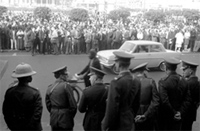 Crowd and police outside the court during the Rivonia Trial
Crowd and police outside the court during the Rivonia Trial
The courtroom was divided into black and white sections, and Albertina Sisulu sat in the black section. When Hilda Bernstein tried to talk to Mrs Sisulu, a policeman prevented any contact, and ordered Bernstein to return to the white section. The prisoners were seated on a long wooden bench specially built for the trial.
The prosecution was led by the 52-year-old Deputy Attorney General for the Transvaal Province,Percy Yutar. A ‘small, dapper balding man with a deformed left hand and a supercilious smile’, Yutar was reputed to be ‘an aggressive, flamboyant prosecutor with a flair for cross examination and a passion for publicity’ (Glenn Franklin, Rivonia’s Children, p184).
The defence team was led by Bram Fischer, senior counsel. His team, put together by Joel Joffe, who had been Jimmy Kantor’s partner, included Vernon Berrange, an accomplished and aggressive cross examiner, Geroge Bizos and Arthur Chaskalson, both junior counsellors.
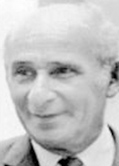 Percy Yutar, the lead prosecutor at the Rivonia Trial
Percy Yutar, the lead prosecutor at the Rivonia Trial
The trial was presided over by 65-year-old Justice Quartus de Wet, Judge President of the Transvaal. De Wet, himself the son of a judge, was known to be an experienced, independent and ‘no-nonsense’ jurist. He had been appointed before the Nationalists came to power, a fact that yielded a sliver of hope for the accused and their supporters, who had been told by a grave Fischer that the death sentence was a highly likely outcome.
Yutar, the first to speak, set out the case. ‘My Lord, I call the case of The State versus the National High Command and Others,’ he said, and handed in the charge sheet, which was made available to the defence for the first time. It set out four main charges: that the defendants, ‘acting in concert and conspiring and making in common purpose with 70 co-conspirators, the ANC and the Communist Party, had “incited, instigated, commanded, aided, advised, encouraged or procured other persons to commit the wrongful and wilful acts of sabotage, preparatory to and in facilitation of guerrilla warfare in the Republic of South Africa, coupled with an armed invasion and violent revolution’.
The defence asked for six weeks to review the case, since they had been given the indictment for the first time, but the judge gave them just three weeks to prepare their case, and the trial was set to resume on 29 October 1963. On the appointed date, the trial resumed. Bram Fischer made a detailed analysis of the four-page indictment, arguing that the prosecution’s case was incoherent, and contained little detail as to who carried out particular acts of sabotage, thus making it impossible for the defence to link the acts to any of their clients and mount a defence. There were also gross inconsistencies, one being that Mandela had been in prison when 156 of the acts of sabotage had been committed.
Next, James Kantor’s lawyer George Lowen argued for the release of his client – on the grounds that he was not connected to the defendants, to the ANC, MK or the SACP, and that he was being charged for acts committed by his brother-in-law, Harold Wolpe. Yutar then made a shocking revelation, announcing that Bob Hepple had turned state witness and that the charges against him had been withdrawn. Hepple was then released and walked out, apparently a free man.
When Yutar tried to argue against the indictment being quashed, Judge de Wet pointed out that Yutar’s arguments were based on the assumption that the accused were guilty, and chided: ‘You can’t beg the question”¦ A preliminary matter like this must be approached from the assumption that the accused are not guilty.’ Judge de Wet dismissed the charges, and Yutar was crushed, but the defendants were immediately recharged for sabotage.
A little later, Kantor’s case came up, and this time he was defended by Harry Schwarz, a liberal who later entered politics. But Yutar argued against bail for Kantor, and he was kept in prison. A few days later the police offered him a deal: they would let him go free if he turned against his co-accused, but he refused. Two weeks later, in mid-November, the accused appeared at the Palace of Justice, and this time Yutar came up with a nine-page indictment, together 40 pages that detailed 193 acts of sabotage allegedly committed by 122 people. Kantor was now included in the indictment, the police having manufactured ‘new evidence’. In a late-November hearing, the defence tried to have the new indictment quashed, but the judge upheld it. They were in for the long haul.
Meanwhile, Bob Hepple had fled into exile, and he released a statement from Tanganyika (now Tanzania), published in the Rand Daily Mail, refuting Yutar’s allegations that he had been threatened by the ANC. On 3 December 1963, the accused were asked to plead, and they all pleaded not guilty, with Mandela adding: ‘My Lord, it is not I but the government that should sit in the dock today. I plead not guilty.’ The others echoed his stance.
Yutar then stood up to make his opening address, but before he could continue, Fischer objected to the address being broadcast on the SA Broadcasting Corporation, arguing that the airing would prejudice his clients. The judge acceded, and Yutar’s attempts at self-publicity were dashed.
The Prosecution’s Case
Yutar’s address set out the prosecution’s case, arguing that the accused planned to mount a campaign of sabotage that would be followed by guerrilla warfare and an armed invasion. The ANC had established MK for this purpose and the law firm James Kantor & Partners laundered money that was used to buy Lilliesleaf to use as a base for their operations. The accused were frequent visitors to the farm, as were Joe Slovo and Harold Wolpe. They made plans to construct bombs and used young African men to carry out acts which they the accused themselves never carried out.
Yutar was guilty of certain absurdities, such as that March 1963 was set as the year of revolution and liberation from white rule – highlighting the mishmash that was the indictment (it was the PAC’s Patrick Laballo who had declared that 1963 would be the year of liberation).
Yutar then paraded a string of state witnesses, many of them having undergone torture. They were blackmailed into testifying, and were being kept in renewed periods of 90-day detention, their only hope of going free dependent on whether they said what the police wanted them to say. The first was Edith Ngopeni, a domestic worker at Lilliesleaf. Fischer challenged the legality of her detention, but Yutar argued that she was being held in ‘protective custody’, which the jusge accepted.
Next came Thomas Mashifane, who had been a domestic worker at Lilliesleaf. He identified the accused as people he saw at the farm, except for James Kantor. He then told the judge that he had been assaulted by police who wanted him to change his original statement. De Wet asked Yutar to look into the matter, and after the lunch break Yutar informed the judge that a policeman had spoken to Mashifane, who had decided not to make a statement. The judge failed to press the issue further.
The most serious testimony came from ‘Mr X’, known to the defendants as Bruno Mtolo, a former senior MK operative from Natal. Mtolo, who had had been a petty thief before joining MK, testified over three days that he had himself been a saboteur, and had carried out acts of sabotage under instruction from the MK High Command. He did, however, concede that saboteurs had been instructed to target infrastructure without causing harm to any human beings.
He justified his betrayal by saying that the MK High Command lived luxurious lives, and took instructions from white communists. He claimed Walter Sisulu owned cars when, in fact, Sisulu could not drive! Although Mtolo embellished the truth, and indeed lied about many details, in essence his account was damning for Mandela, Sisulu, Mbeki and Mlangeni.
Cyril Davids, Mr Y, also an MK operative who had also turned and was still in detention, said he attended a training camp organised by Denis Goldberg. Patrick Mthembu, dubbed Mr Z by Yutar, testified that Elias Motsoaledi had engaged in sabotage. Under cross-examination he also revealed that he had been kept in solitary confinement.
Police witnesses followed, with a Sergeant Card revealing the police’s method of extracting information from detainees: ‘We will tell them what we want to know, and wait until he confirms it.’ Dirker lied, and said he found the plans for Operation Mayibuye on a table when in fact Hepple had stuffed it into a stove. He also said that he had checked Rusty Bernstein’s car by opening the bonnet and checking the engine for its temperature, which was cool. In fact Bernstein had only been at Lilliesleaf for 10 minutes before the police raid, and his car alarm would have been set off if the bonnet was opened. Also Bernstein, a banned person, had checked in at the Marshall Square police station a short while before the raid.
Other witnesses testified that Denis Goldberg had procured items that were used to construct explosives. When Ismail Essop Makda, a law clerk in James Kantor’s firm, presented evidence that contradicted the state’s case against Kantor, Yutar was furious, and the judge cautioned him against cross-examining his own witness.
The trial went into recess for the Christmas period and resumed on 13 January 1964, when taxi driver Essop Suliman testified that he had been employed by Sisulu, Kathrada, Mlangeni and Motsoaledi to ferry MK recruits to the border with Bechuanaland (Botswana). Berrange established that he had been in detention for 120 days before testifying.
Over the next five or six weeks Yutar presented a series of state witnesses. James Kantor was allowed bail and went home for the birth of his first child, but police kept a tight watch over him, claiming that he was planning to flee the country. Late in February he was once again behind bars, and police witnesses testified against Kantor, but Judge de Wet concluded that there was no case against him, and set him free. The trial went into recess for five weeks.
The Case for the Defence
During the recess, the accused set out their strategy, and they all agreed that Nelson Mandela would be the first to take the stand. Mandela decided to make a statement rather than face examination, a move allowed in South African law. He had done the same thing in his previous trial, and it would present him with the opportunity to set out the moral case for the ANC’s struggle against apartheid.
The case against Kathrada, Mhlaba and Bernstein had not been conclusive, and it was agreed that their testimony could sway the judge to find them not guilty. In general, the defence team urged that the defendants should not testify, but George Bizos was convinced that Yutar’s cross-examination would allow the defendants to appeal to the judge’s humanity, and so avert the death sentence.
Mandela worked on his statement over the next few weeks, and at the request of Bizos, Nadine Gordimer and British journalist Anthony Sampson edited and refined the speech he would make. Mandela welcomed their input, but he was strongly opposed to the lawyers’ insistence that he leave out the final sentence of his speech, which he professes that he is prepared to die for his beliefs.
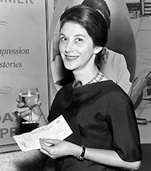 Nadine Gordimer, one of the two people who edited Mandela’s statement on the dock
Nadine Gordimer, one of the two people who edited Mandela’s statement on the dock
The defence team sought to make four points:
1. They would say that most of the defendants had participated in MK, but would refute the idea that Kathrada, Mhlaba and Goldberg were members of he MK High Command. They would deny that Kathrada and Bernstein were even members of MK.
2. They would deny that MK was a wing of the ANC, and that the two were quite separate.
3. They would dispute the claim that the ANC was a tool of the Communist Party.
4. They would deny that MK had adopted Operation Mayibuye.
Mandela Speaks
The trial resumed on 20 April, 1964, and the defence began presenting its case. When Bram Fischer announced that Mandela would make a statement instead of facing cross-examination, Yutar objected, but the judge admonished him, and Fischer informed him that defence counsel was quite conversant with the Criminal Code, which allowed for their strategy. From the start, Mandela had decided that he would not deny the essential facts of the case against him, and instead put the apartheid system in the dock.
Mandela began by admitting that he had been a founder member of MK, and objected to the claim that the struggle was being dominated by communists or foreigners. He presented a history of his life and how he came to join the ANC, and set out the reasons why they had begun to engage in sabotage, a choice they had made in a calm and sober fashion. He justified the resort to sabotage, saying that they had very reluctantly revised their 50-year commitment to non-violence because whites had refused to share power, and their aim was to avert a civil war. ‘The hard facts were that more than fifty years of non-violence had brought the African people nothing but more and more repressive legislation, and fewer and fewer rights.’
He reviewed the ANC’s relationship with communists, who emphasised class distinctions while African nationalists sought to harmonise relations between classes, and had never advocated revolutionary change in the economic structure or condemned capitalist society. He said they had co-operated with communists because they had a common goal, the removal of white supremacy, and added that white members of the CPSA and SACP were the only political group ‘who were prepared to treat Africans as human beings and their equals, who were prepared to eat with us, talk with us, live with us and work with us’.
He said he was an African patriot and not a communist, but was attracted to the idea of a classless society. He respected the parliamentary system of democracy, which the communists shunned. He was committed to a multiracial democracy. He concluded with the most famous section of his speech:
‘During my lifetime I have fought against white domination, and I have fought against black domination. I have cherished the ideal of a democratic and free society in which all persons live together in harmony and with equal opportunities. It is an ideal which I hope to live for and to achieve. But if needs be, it is an ideal for which I am prepared to die.’
Mandela delivered this last sentence while looking directly at Judge Quartus de Wet who, according to Mandela, never after that made eye contact with him throughout the remainder of the trial.
The Accused Cross-examined
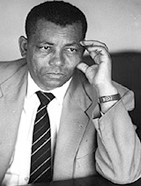 Walter Sisulu took the stand after Mandela
Walter Sisulu took the stand after Mandela
Walter Sisulu was next to take the stand, and Fischer got him to present his life history and his involvement in politics. Sisulu told of how he had been banned, confined, separated from his family, and of how he had assumed certain MK duties after Mandela’s arrest. He stated that Operation Mayibuye had divided the High Command, and announced that he had no regrets about his involvement in the struggle.
When Yutar began to cross-examine him, he skilfully sidesteped the prosecutor’s attempts to prove that Sisulu and his comrades were murderers. Sisulu repeated the policy of the ANC and MK, saying that they would take every precaution to ensure that no deaths were caused by acts of sabotage. When Yutar tried to get Sisulu to reveal information that would implicate others and be used by the security police to arrest people, he refused to answer, exaspering the prosecutor.
When Yutar asked him about Chief Luthuli’s role in MK, he refused to answer. Yutar asked why Denis Goldberg had left Cape Town, Sisulu replied that Goldberg was avoiding arrest. Yutar said police did not arrest people indiscriminately, and Sisulu set out to demonstrate that that was exactly what the police did. ‘I know. They arrested my wife; they arrested my son.’
Yutar subjected Sisulu to five days of questioning, and Sisulu was calm and dignified, only once losing his composure, shouting at Yutar: ‘I wish you were in the position of an African. I wish you were an African to know the position in this country!’ Yutar tried to present Operation Mayibuye as ANC and MK policy, but Sisulu denied this, presenting it as an unrealistic plan. Yutar failed to demonstrate his claim, and gave up after a weekend recess.
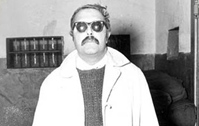 Ahmed Kathrada took the stand and was cross examined by Percy Yutar
Ahmed Kathrada took the stand and was cross examined by Percy Yutar
Ahmed Kathrada took the stand, and Yutar managed to bait him when he said Kathrada had called the cabinet criminals. Kathrada snapped: ‘That’s what they are!’ Yutar pointed to the fact that India and Ghana had detention laws, and managed to establish that Kathrada was a member of the SACP and a supporter of MK.
When Raymond Mhlaba took the stand, the judge seemed to disbelieve everything he said, including his denial that he had played any role in MK. Bernstein claimed he had never heard of Mayibuye until after his arrest. The remaining four defendants were quickly dispensed with. Govan Mbeki shocked Yutar when he said he was guilty of all four charges, but had pleaded not guilty because his taking the stand would provide the opportunity to explain why he had joined MK. ‘I do not accept that there is any moral guilt attached to my actions,’ he said.
Denis Goldberg was unrepentant about his involvement, and Elias Motsoaledi and Andre Mlangeni made short statements from the dock and did not testify. Mlangeni spoke of being tortured at Pretoria Central Prison. The defence, having called all its witnesses, rested.
Summing Up
Percy Yutar began his summing up on 20 May 1964, reading out three of four thick volumes which he had distributed to the press. He asserted: ‘Although the State has charged the accused with Sabotage, this is nevertheless a a case of High Treason par excellence.’
He went on to launch vicious personal attacks on the defendants, accusing them of insurrection, revolutionary intent, deceit, cowardice, callousness. He said they had arrogated to themselves leadership of the ‘Bantu’ when they represented only one percent of the African population. Eventually the judge cut him short, and asked him: ‘You do concede that you failed to prove guerrilla warfare was ever decided upon, do you not?’
Shocked, he said that the State had proved that the accused had made preparations for guerrilla warfare, and Judge de Wet retorted that the defence had conceded the point, but that they had not taken a decision to engage in guerrilla warfare before they were arrested.
Yutar then accused the defendants of being responsible for the Sharpeville Massacre, and proceeded to summarise the evidence against each of the defendants. The judge again interrupted him, saying that Mandela had pleaded guilty to all the charges, so there was no point in his summary. He then attempted make a ridiculous joke by naming a ‘shadow cabinet for the provisional government’, and concluded that the case was one of murder and attempted murder, clearly implying that the death penalty was called for. Finally he praised the security police for saving the country from a ‘bloody civil war’.
The defence team’s summary began with Arthur Chaskalson arguing against the charge of murder and a careful analysis of the legal holes in the prosecution’s case. Bram Fischer then argued that neither the ANC nor MK had decided on guerrilla warfare and that although the two organisations were closely connected, they were separate and autonomous. The judge intervened to say that although Mayibuye had not been adopted, it was possible that it would have been.
Vernon Berrange focused on Kathrada, Mhlaba and Bernstein after criticising Yutar’s conduct, especially his ‘shadow cabinet’ stunt. He argued against the prosecution’s cases against the trio.
Verdict and Sentence
Judge Quartus de Wet delivered his verdict at 10am on 11 June 1964. All the accused except Kathrada were found guilty of all four counts, and Kathrada was found guilty on count two. Bernstein was discharged after being found not guilty, but was rearrested before he could leave the court. The judge then adjourned the court.
When the lawyers met with the defendants at Pretoria Local prison, they were stunned to hear that the convicted comrades had decided against an appeal, which they argued would be seen as an act of weakness. De Wet delivered his sentence the next day in a court packed with relatives, police and the press. But before he did this, the defence presented Alan Paton to argue in mitigation of sentence.
The novelist, a committed pacifist and leader of the Liberal Party, argued that Afrikaner rebels who had opposed the government’s stance in the two World Wars had been pardoned, implying that the same should be done for Mandela and his comrades; that African leaders had been forced by the government to respond with violence because their peaceful methods had been ignored; and finally that Afrikanerdom would never recover from the disgrace that would follow if the convicted men were executed. He described Mandela, Sisulu and Mbeki as honourable men devoted to their people, and added that clemency would bode well for the future.
Percy Yutar then took the unprecedented step of cross-examining someone presenting mitigation, ‘to unmask this gentleman’ whose only reason for appearing was to ‘make political propaganda’, he said. He asked Paton if he was a communist, and poured scorn on everything Paton said.
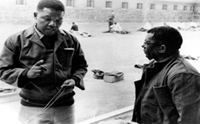 Nelson Mandela and Walter Sisulu on Robben Island
Nelson Mandela and Walter Sisulu on Robben Island
The judge then spoke, and repeated Yutar’s notion that the charge was ‘in essence, one of high Treason’. But he said: ‘I have decided not to impose the supreme penalty”¦ but it is the only leniency I can show. The sentence in the case of all the accused will be one of life imprisonment.
Until then, a life sentence meant 15 years in prison, but in February 1964, Minister of Justice BJ Vorster announced that ‘the customary remission of sentence applicable to common criminals’ would not apply to political prisoners (Welsh). So it was a forgone conclusion that the Rivonia trialists would spend the rest of their days behind bars.
• Kathrada, A., (2004), Memoirs (Zebra Press)
• Mandela, N., (1994), Long Walk to Freedom (Mcdonald Purnell)
Last updated : 25-Nov-2013
– See more at: http://www.sahistory.org.za/topic/rivonia-trial-fifty-years-later#sthash.PdKabZcO.dpuf

